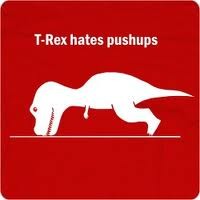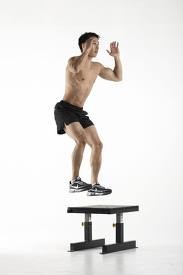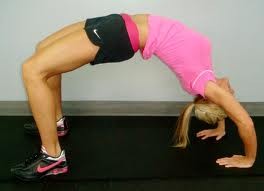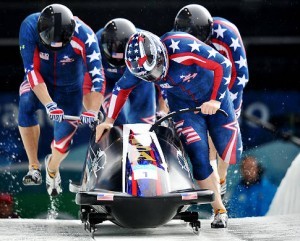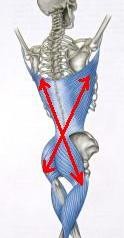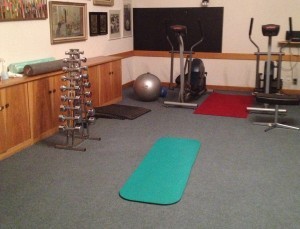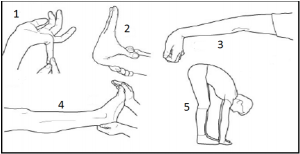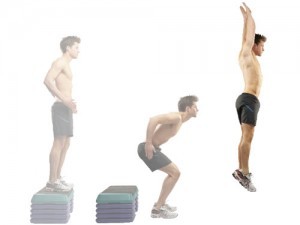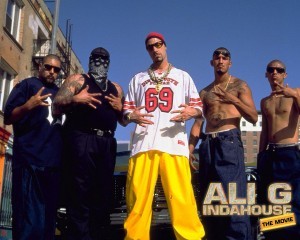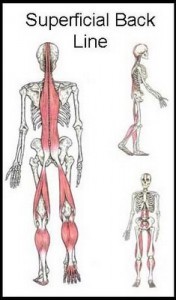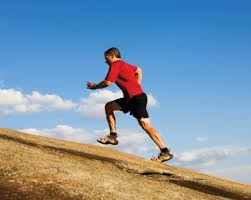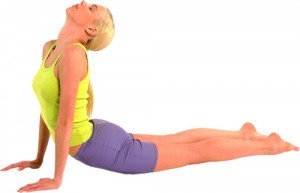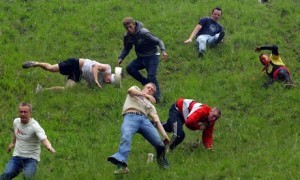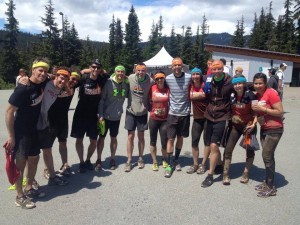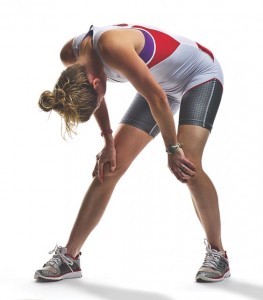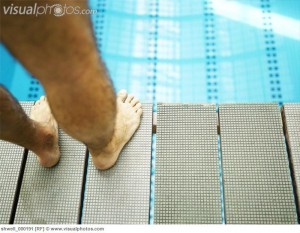When it comes to coaching everyone has a different style. Sure we pick things up from different coaches here and there. We'll steal a tip from this one. We'll adopt a practice from that one. But for the most part we have to figure what our style is and then develop it to the best of our ability. Learning to Lift Analogies For me one of the things I like to use when coaching is analogies. Big surprise right! Why analogies? Well because it allows the coach and client to find a common reference point regarding the concept being addressed. It gets away from the specific language and terms that both people may people may not be familiar. Analogies can also make the experience more fun. Because when someone steps on the training room floor they be very unaware of the technique required to perform a lift. Some may think they know what they're doing and then as a coach when you watch them lift you realize they don't. So you need to step in and coach them. Here's how I like to coach a lift. Analogies Save Time & Money First, of all don't let someone continue performing lots of reps the wrong way. This just ingrains a poor motor program which is then harder to fix later. For example, I wouldn't look over and say to myself 'wow, that guy (or girl) is using terrible form on their deadlifts! I should talk to them later.' That would be like watching someone drive past you in their car going the wrong way and you don't stop them. You let them continue on thinking they are making progress in the right direction but instead they are wasting time and money. Worse the path they are headed down may cause extensive damage...
Ugly When Naked - New Fitness Program
- Chris Collins
- Fitness
- Training
- Motivational
- 1910 Hits
- 2 Comments
-
Well the clock just ticked into March and that means me and my little training buddy (whom I will simply refer to as “Dave” thanks to my congenital lack of respect for his personal privacy) got a whole new mess of exercises to learn. Now personally I love getting a set of fresh moves. And it’s not that I’m a hyper-keener or something. Sure, I like learning new things and acquiring new experiences and all but the main reason they garner my affection so is that as an inherently lazy sod the first couple weeks doing them usually allows for a ton of rest time as we “perfect” (wink-wink) our overall form. Compare that to the ones we already know that simply grow in weight or complexity from week to week. Seriously, some of the hardcore ones even give me night sweats just thinking about them…. (see wall pushups and nearly anything involving the general area around my waist…) Changing Up the Program Keeps Things Fresh I certainly understand the accepted reasons for changing things up. I mean, if we just concentrated on the exact same movements, day in and out, for months on end we’d either overwork certain areas of the body well-past exhaustion or develop some sort of weird muscle enhancement that looks more like the results of an experimental drug trial. Another risk-factor, at least to my mind, is the opportunity to get sloppy as you rush through stuff ‘cause now you think you know it all. Basically, by getting too comfortable at the gym you become “that guy.” You know him, the silly knob that always uses too much weight in some bizarre quest to either pop a ring of blood vessels in his neck or perhaps detach his quadriceps whilst screaming like the Hulk? Trainers Help...
8 Things to Prevent a Bone Fracture
[caption id="attachment_3199" align="alignleft" width="183"] Proper landing mechanics are an essential part of injury prevention.Are you following the NCAA basketball? Or March Madness as it is more commonly known? I think this is one of the best sports tournaments going because it has such as great format with the 'one-and-done' arrangement. To be honest I don't spend a lot of time watching college basketball during the year. But when March rolls around I try and check out a few games. This year is even more special as I got to go to some games. While I was down to California for a conference I managed to find some tickets on Craigslist for the games in San Jose. What a blast! What made it even more fun was the fact that I was able to keep it a secret from Megan right up until tip off at the arena. But although the experience was once in a lifetime and a fun thing to do on the side at the conference I actually want to talk about a game we didn't see. The one where Kevin Ware, from Louisville, broke his leg. Now if you have a weak stomach don't go check it out on youtube. And sorry Jordy, but blurring your eyes when you watch doesn't prevent nightmares. Anyways after seeing this horrifying accident I thought to myself 'I wonder if he had been doing x-y-z prior to the accident?' And I also thought this might interesting and useful for you as well. So here are 8 Things to Prevent a Bone Fracture. 1. Eccentric Training One of the first things that comes to mind is eccentric training which is the portion of a muscular contraction when the muscle is being lengthened. This is when most injuries happen so it makes sense to...
Fitness Family - It's Not Just for Mom & Dad
- Chris Collins
- Fitness
- Training
- Motivational
- 1826 Hits
- 0 Comments
-
FITNESS FAMILY I just dropped my twelve-year old son off at the gym. He goes every second day for tennis lessons – and then every other day for matches. But that’s beside the point. The interesting thing for me is that he is twelve and I am taking him to HIS gym – a place separate from my own. Add to this that my wife heads off to her women's only gym each day too. Plus, we have a treadmill at home, weight bench, weights, mats, strength cords, etc. I cannot believe how much fitness and fitness-related activities have become such a massive part of our lives. When my kids whine (and believe me they do, a lot) it’s often along the lines of “Are you and mom going to the gym AGAIN?” Fitness Family for the New Millenium My parents never went to a gym – or really ever exercised formally in any way. We did tons of stuff together. We played sports, rode bikes, games, ran, jumped, playgrounds, what have you but the idea of a gym or a trainer was simply non-existent to us. For years my dad worked at jobs that were both physical and tough on the body. He didn’t need cardio and weight training. He got them at work. And mom had way less labour saving devices helping her out at home the way we do now. But it was also different then. The suggestion that you needed to run like some hamster in a wheel was mocked and laughed at. Who did that sort of thing, except maybe some Hollywood celebs and the odd body-building fitness weirdo? Nobody – that’s who. And that reality wasn’t so long gone in the rear-view either. I listened to ex-CFLer Jay Christiansen explain that not only did he fail to weight...
Heart Rate Variability
Recently we've incorporated a couple of new technologies at Okanagan Peak Performance Inc. This supports our goal for you which is to get you better results in less time. And by incorporating these technologies we know that we will be able to help you recover from your injury, lose more weight and compete at a higher level.So what are these new technologies?They are Bioforce HRV units and Polar Heart Rate monitors. And I know what you're thinking. There's nothing new about heart rate monitors. And you'd be right. But how many of the people who know the benefits of training with a heart monitor actually use one? Very few. It's kind of like back when people owned VCRs but nobody ever programmed it and instead it flashed 12:00.So we've made a bulk order with Polar to be able to supply all of our clients with heart rate monitors.And the heart rate monitors came about as a result of a need to be able to use the Bioforce HRV units. So what exactly is a Bioforce HRV?Well HRV stands for heart rate variability and is a measure of magnitude of change between heart beats. This was developed by the Russians in the 60s when they would send cosmonauts into space and needed a way be able to monitor their health. Some of the only data coming back from space was heart rate data which the scientists were able to break apart and determine that there is valuable information contained within the heart beat.When there is a lot of variability between heart beats we could say an individual is fit or well rested and recovered. On the other hand if the variability between heart beats was minimal this could be indicative of someone in poor shape or someone who needs a rest day.This is not the same as simply measuring the pulse of...
Slowing Down Training
- Chris Collins
- Fitness
- Training
- Injury Prevention
- 1758 Hits
- 2 Comments
-
'Train slow - Best slow' Have you heard this saying before? I want to give credit to legendary strength & conditioning coach Al Vermeil as he's been known to have a number of original saying related to training. Another one I know for sure Al said was related to plyos where he said 'the bigger the athlete the smaller the hurdle' (or box). But back to the original statement this has to do with the specificity of training. If you are an athlete that requires speed it is important to use movement, drills and exercises that develop the capacity of the athlete to move and perform at a high velocity. And typically what happens is people watch YouTube videos of people performing insanely high box jumps or their favourite athlete is featured in a commercial doing something explosive. All of a sudden everyone wants to start there. Day 1 and they want to do max height box jumps, plyos, Olympic lifts and anything else that is worthy of a facebook post. Let's face it there aren't too many 'likes' for someone being able to hold a proper plank for 60 seconds. So do we really have to 'go big or go home'? Is there value to slowing things down a bit? Can you still achieve your potential without going all out all the time? The answer to all of these is No-Yes-Yes. In particular there are a couple of times when slower is better. In particular when you are performing stability or balance drills there is more benefit to slowing things down. Consider the following couple of scenarios. Slowing Down Plyometrics An athlete could be performing Heidens, bounding from one leg to the other. This is a great drill to develop power in the frontal plane. When this drill is performed with...
Man of Steel Chest Workout
- Chris Collins
- Fitness
- Training
- 1898 Hits
- 1 Comment
-
Man of Steel opens this Friday. And I'm sure I'm not alone when I say I've been waiting for this for quite a while. Don't get me wrong I think the Batman movies were great but Superman was always number for me. The guy came from another planet. He could fly, had x-ray vision and of course has super-strength. And to help us identify with him we knew he had a problem with kryptonite. We could look at our weaknesses to cupcakes, cookies, soda and other sugary snacks as our kryptonite and pretend we're super heroes too. But looking at Superman's strength in particular he was always depicted with hands on hips and his cape flowing in the background. But we were drawn to his chest because of his strength and the fact that this is where his logo was displayed. Come to think of it you may have already guessed I was a fan of Superman when coaching certain movements. When trying to get someone to get their chest up I might say 'Superman chest'. Right away everyone thinks of pushing the chest up and at the same time getting their shoulders to descend and relax. So with this movie about to open in a few days I thought I would put together a quick Man of Steel chest workout for you. I think you'll like this workout because: 1. It takes less than 10 minutes to do with less than five minutes of actually training. 2. It requires no equipment. 3. It requires no space. 4. It can be easily regressed or progressed based on abilities. 5. It gets you jacked for Man of Steel. (I know, this should have been the one and only reason to do this) Read on for the protocol for this workout and to...
Father's Day Specific Workout
- Chris Collins
- Fitness
- Training
- 1719 Hits
- 0 Comments
-
It's Father's Day weekend. And I now have a small appreciation for all the things that dad's do for us. But although many may think their dad's are superheroes the truth is they're not and it may take some effort and training to be able to do all the things that dad's do so well. What kinds of things dad's do for us? Well have about the following?* mowing the lawn* carrying kids around on their shoulders* reaching up to change light bulbs in the high places* cracking the whip to get kids going* repairing things* tending the BBQ* kills bugs Now I don't mean to be sexist because we all know many women can do these jobs as well as women. And in many households I'm sure it's the women who take care of most of the items on this list. And I didn't include managing the remote for the TV because that goes without saying that this obviously a dad's job. Ok now I'm being sexist. But since we know our dad's are regular people they would therefore need to a training program to allow them to do all of these tasks as efficiently as possible. Check out the video below for the Father Day's Workout to ensure everything dad does for trained for properly. http://www.youtube.com/watch?v=6XN4jKisdWA What did you think? Pretty good workout isn't it? We have some upperbody pulling and some whole body extension. There's some lowerbody and rotation. It includes a metabolic element and a drill that draws on the core. Lastly there is an exercise for the shoulders and finishes with a hip mobility drill. A little bit of everything to cover all dad's bases. Do me a favour and share this with your dad. And if you are a dad give it a try yourself....
Top 7 Reasons for Entering a Competitive Sporting Event
- Chris Collins
- Fitness
- Training
- Motivational
- 1959 Hits
- 1 Comment
-
Team OPP just returned from the Tough Mudder in Whistler. And we killed it!By this I mean that we all:* completed the race* didn't suffer any type of injury* all bounced back as quickly as the next day* shaved up to 50 minutes off last year's time (way to go girls!)But what about you?Have you ever trained for a specific race or event?Maybe it was a triathlon or a powerlifting competition. You might like to run and entered a 10 k or half marathon.Whatever the event was there are a number of benefits of putting your name down for an event. Below are the Top 7 Reasons for Entering a Competitive Sporting Event.#1 - Increased Training IntensityFor most people knowing that they will have to face some type of challenge will help them to dig a little deeper during training and push harder.For me it was the hill beside the ski jump at Olympic Park in Whistler. Last year this climb destroyed me and I kept reminding myself that this wasn't going to be a repeat. Every step on the sand-dunes or run around the block with a sandbag was inspired by the thought of last year's event.But even if you don't have a previous experience to draw upon it's pretty easy to picture your opponent doing a little extra to gain an advantage. And you don't want them to get ahead or in competition when it matters so you up your game as well.#2 - End Point in SightWhich is harder to train indefinitely until a coach says 'stop' or to perform a set amount of an exercise, even if it's a lot, and know you're done when you get there?Obviously knowing when you're done is easier. And when you're going through a tough phase of training it's much easier...
Good Exercises Done Wrong - Stability Ball Hands to Feet
I remember a number of years ago when I first got started in the training industry. And I attended a fitness conference down in Vancouver. This would be the first time I would get to see and meet Peter Twist, who at the time was the strength & conditioning coach for the Vancouver Canucks. Now Peter was a big advocate of using balance tools in training and incorporated a number of different exercises using stability balls, balance boards and BOSU trainers. And if the novelty of a new training toy wasn't enough to get the average exercise, or athlete for that matter, excited about training I don't know what would. But to make even more enticing we found lots of ways to perform our core training on a balance or stability ball. One of the exercises that came out of this period of training was the stability ball pass from hand to foot. To perform you start in a supine (on your back) position with a stability ball between the feet. The arms are straight and overhead on the ground. The legs are lifted off the ground and the ball is passed to the hands over the trunk. The ball is then reached overhead as the legs are lowered to the ground in a controlled manner. When performed properly this is a great drill. It incorporates hip & shoulder flexion while having to stabilize through the lumbar region. And who doesn't need more hip & shoulder mobility plus core stability, right? This seems like a great drill. Unless of course we compensate when we perform the drill. How do we compensate? Well imagine that your core stability determines how low you can lower your legs towards the ground when they start in a vertical position. A stable core will allow the...
Ditch the Flip Flops
Do you remember a few years ago when minimalist shoes became all the rage? In particular I'm talking about the 5 Finger shoes where each toe has a separate compartment like gloves for your hands. People would wear these for training in the gym, while doing daily errands and even to some work places. And an interesting thing seemed to occur when people starting wearing this type of footwear. First they noticed improved function at the joints through the lower extremities such as the foot, ankle, knee and hip. If they had back pain they maybe noticed that this was lessened or less frequently a problem. As well due to the physical separation of the toes and the lack of a built in arch support the structure of the foot began to change. Due to the physical separation of the toes the feet developed a wider platform. This became really noticeable when at a houseboat party for my wife's work and I had my shoes off and my toes were splayed widely compared to everyone else's toes which looked like sardines packed in a shoe container. The other difference you will notice with wearing minimalist shoes is the shortening of the foot. Why does the foot shorten? Well since there is no external arch support we must develop our own arches and therefore this lifts the foot through the middle. The higher arch shortens the distances from the toes to the heels and so you may notice your regular shoes fit a little looser. But not all minimalist shoes are your best option. With the 5 Finger variety there are a number of benefits including the independent articulation of the toes, the development of the arch, the flexibility of the sole to allow more ground contact and the lower heel position....
Review of 5 Fitness Apps
Apps sure have become a big part of our lives. And with what we do at Okanagan Peak Performance Inc it's inevitable that we see more people using apps to track their health, log their nutrition and structure their workouts. With more and more people owning smart phones it's reasonable to expect the number of fitness apps and users to climb. Currently it is estimated that 20% of smart phone owners have a least one fitness app. So I took some time to check out some of the more popular fitness apps out there. Here's what I found. 1. My Fitness Pal - free http://www.myfitnesspal.com/ Because it's a free app you will see ads bordering the pages of the app. And I'd say that's a small price to pay for a resource that helps you track your nutrition. And with 40 million users apparently others don't mind a little monetization from some ads either. This app also includes a section for exercise but I would pass on it using it for exercise help for a couple of reasons. One is it estimates caloric expenditure based on the exercise type. Looking under 'S' I couldn't find squat. Not good. I eventually did find an entry for squat but when it asked me for minutes of squatting rather than load and reps I knew we can do better. 2. Fitness Buddy - $0.99 http://fitnessbuddyapp.com/ While the previous app was geared around your nutrition this one is all about your workouts. The workouts seem to be a bodybuilding style of training where you select body parts to put a particular emphasis for a workout. So you might choose Butt and Thigh Toning or a Big Chest Program. From the looks of the app it includes pictures rather than videos of how to perform the...
The Value of the Warm Up
- Chris Collins
- Fitness
- Training
- Injury Prevention
- 1819 Hits
- 0 Comments
-
So yesterday I had the chance the play a round of golf with a buddy, Jim, and he invited a couple of friends which was great. I actually knew one of the guys from many years ago at a gym in downtown Kelowna called Flex Fitness. Anybody remember that place? Anyways Jim and I planned to have lunch on the course and then hit a few balls before teeing off. Well we got involved in conversations about travel and other things that we didn't realize that we hadn't gotten our food and we had about 10 minutes until we were due up at the first hole. Needless to say we didn't hit any balls at the range and went straight from the restaurant to the first tee where we both proceeded to find the sand. While it was a beautiful day I would have been okay with the middle of the fairway rather than the beach. To summarize the round I was about 11 strokes better on the back nine than the front. And I attribute a large part of this difference from a lack of a warm up before playing. And it got to thinking back to a study I had read in the Journal of Strength & Conditioning Research which had 30 military cadets performing a number of agility and power tests after either: * a dynamic warm-up* a static stretching warm-up* or no warm-up at all The tests were a T-shuttle run to measure agility as well as a medicine ball throw and a jump test. What they found is that the dynamic warm-up group outperformed the other two groups on all three tests. There was no significant difference between the static stretching group and no warm-up group on the agility or med ball throw but the static...
Dad Is Fat - But Doesn't Have To Be
When you get out of the shower are you happy with what you see? Based on the title of this blog I'm obviously talking to the guys here. Although there may be a few wives that quickly answered for them before their husbands had a chance. But seriously though are you happy with the way your body looks? No sucking in your gut. No standing sideways to the mirror. No adjusting the dimmer switch to create the perfect lighting conditions where you look your best. There are a number of things working against here and you can quickly see the difference a few decades can have on the male physique. From when we were teenagers and could eat anything any everything and burn off all this extra energy. To our twenties where we first heard the term 'freshman ten' or in some cases 'twenty'. And later to our thirties where some of the cool styles and fashion trends don't necessarily suit the body of the out-of-shape thirty something. And now that I'm in my forties I see more and more people of this vintage looking more like their parents than their kids. We look less like our high school grad pictures and more like the old pictures of relatives we would smile at when looking through photo albums. Why does this happen? And more importantly, is there anything we can do about it? Well to answer the first question would take more than a blog post unto itself. But the short answer is that we aren't the young kids smiling back at us in those pictures from summer vacation 15 or 20 years ago. We aren't producing anywhere near the same amount of androgens as we did up until our early twenties. The levels of testosterone, DHEA, androstenedione (Mark Maguire) in...
My Weekend Trip to Spokane
- Chris Collins
- Fitness
- Training
- Motivational
- 8700 Hits
- 1 Comment
-
Have you ever done something that you thought 'This is not what I signed up for' or 'I'm not sure if I want to be doing this'? This is how I felt last weekend. I was done to Spokane to play in a charity golf tournament for a foundation that supports families of kids with cancer. And this is not the part I had regrets about. Instead it had to do with Saturday morning. Actually let's back that up. It all started on Friday night. I drove down to Washington and arrived at my friend Tim's place to find out he was over another friend's house for 'men's night'. Now I wasn't sure what this meant but since getting up at 5 am, working all day and then driving almost 6 hours I wasn't overly upset about missing out and potentially getting to sleep a little earlier. But Tim, being the good friend and gracious host that he is, came home to bring me back to the party. As we drove up to the home where this was all happening I thought to myself 'are we on the set of MTV cribs?' Let's just say this was a beautiful home with lots of food, beer, wine and drinks of every kind. I was introduced to a CAT-5 which is a drink with ties to New Orleans and hurricanes. At about 1230 am I thought it was time to go when we were all summoned outside for steaks. Now I understand most things Americans say but this made sense. I mean we had already eaten and had more than our fill of drink when I realized they had steaks ready on the Green Egg. ***quick side note...if you've never tried food on a Green Egg you don't know what you're missing*** By...
Segway Running
- Chris Collins
- Fitness
- Training
- Injury Prevention
- 1744 Hits
- 0 Comments
-
Have you ever been on a Segway? Or better yet do you know what a Segway is? You typically see them in larger centres, specifically being ridden by mall security. The rider stands on a platform with a handle in front and two wheels at the base. To initiate movement the rider leans their body forward which is detected by a gyroscope within the unit and results in forward motion. Motions other than leaning the until forward by shifting body-weight won't help in moving the Segway. In the same way the Segway can be stopped by returning the unit to a vertical position, and I am assuming, come to sudden stop if the unit is tilted backwards. We can think about running in the same way. To generate the forward momentum to propel us we need to have our centre of mass in front of the point of ground contact. Some describe running as 'controlled falling'. The body is falling forward and we catch ourselves with each stride just enough to not fall flat on our face but not so much that we can to a complete stop. This forward lean of our bodies needs to be from the ground however. Many hear this concept of having a forward lean and simply bend over at the waist rather than leaning from the ground. By bending forward at the waist a number of bad things happen. 1. Less Stability We don't maintain the tallest spine possible. And a tall spine is a more stable spine. So when we are shorter and we shorten the lengthen of the spine we won't be as stable. A lack of stability means that every time a foot contacts the ground some energy will be lost as it leaked out through point in the kinetic chain where...
Deadlifts Are Bad
So this week we had a client that was seeing a chiropractor and was informed that there was a particular exercise that no one should be doing. And based on the title of this post you already know what the exercise is. But we train a number of our clients with deadlifts. And we don't have DC after our names. So what does this mean? Well since Breaking Bad is done I know you've got nothing else to do but stick around and find out the truth. Which is that deadlifts are not bad. Nor are deep squats. Or bench presses. Or biceps curls in the squat rack. (I threw that last one in as a trick to see if you're still paying attention. I do my biceps curls on the Olympic platform) In fact there is no such thing as a "good exercise" or a "bad exercise". There is only exercise done with proper form or improper form. Simple as that. Because here's the thing...we all deadlift anyways. A deadlift is basically a hinging movement at the hips. So whereas a squat would involve most of the bending to happen at the knees a deadlift involves most of the bending at the hips. Imagine all of the times you may hinge (deadlift) in a day: * picking up your suitcase off the belt at the airport* taking a bow as conductor of the symphony orchestra* closing your gar door when your arms are full of groceries But I would go further than to simply disagree with the premise that deadlifts are bad for you and should be avoided but they are good for you and should be in most people's programs. Why are deadlifts important? Because they promote the ability to remain in extension. Flexion on the other hand:* usually...
Are 800s the Ultimate Fitness Test?
- Chris Collins
- Fitness
- Training
- 1773 Hits
- 0 Comments
-
Have you ever run 800s? If you've competed in track and field there's a good chance you may have some experience with this distance. And therefore you know how awful this event can be. Why is it so awful? Well it's too long of a distance to sprint and not long of a distance to really pace yourself. It's basically 2 to 3 minutes of pure physical discomfort. And if you're into that sort of thing than you've found the perfect workout to inflict as much pain and discomfort as you can handle. But there are a few other reasons I like the 800s as a training distance as it provides valuable feedback as to what you should workout on to improve performance. Below are 4 Benefits of Running 800s. Benefit #1 - Measure of Overall SpeedThe nice thing about 800s is that you do two laps of a track oval to achieve this distance. And based on your time you get a bit of an idea of your overall speed. If you want to know how you compare to the world record you can do two laps and see how close to 1 minute 40 seconds which is the current world record. Are you within 30 seconds of the world record? 60 seconds? More? Test yourself and see how your overall speed ranks. Benefit #2 - Measure of Your PaceAs I mentioned at the beginning you can't sprint an 800 m nor can you pace yourself. And after running this distance a few times you'll quickly learn a bit about your pace. For example, let's say your total time was three minutes which is not too shabby. And your splits were 1 min 40 for the first lap and 1 min 20 for the second. Since most people tire in...
You're Not Doing Tabatas
It seems like high intensity interval training (HIIT) is all the rage these days. Anyone can do it at anytime as frequently as they like and achieve amazing results. Sound too good to be true? That's probably because it is. If you're not familiar with HIIT you may be more familiar with the Tabata protocol or some other version of high intensity short duration exercise. Let me re-phrase that. You may be familiar with the name Tabata but it's unlikely you're familiar with the actual protocol of the study performed by the researcher of the same name. So why is the general population going crazy over HIIT or Tabatas? Well because the landmark study, and others by researchers such as Dr. Martin Gibala, indicate that you can achieve weight loss, improved aerobic function and potential performance with a fraction of the time invested in training as is normally thought to be necessary. Now before I give you some things to consider before jumping into HIIT or Tabatas at your next training session let's quickly review what the Tabata protocol involved. While two groups participated in the study the one we are interested in is the short duration, high intensity group. They did:* sprints on a braked cycle ergometer* 7 or 8 sprints of 20 seconds in duration* 10 seconds rest between sprint attempts* at an intensity of 170% VO2 max* for a 6 week period Now there are a number of things to be aware of here when comparing this protocol to what many exercisers believe there are following when they workout. So with that in mind here are 4 Reasons You're Not Doing Tabatas. Reason #1 - You're not on a bike While it's true there are many benefits of cross-training it's a bit of a stretch to do something...
13 Bonus Hours to Train
- Chris Collins
- Fitness
- Training
- Motivational
- 1670 Hits
- 0 Comments
-
If you're like most people you'll find that time is a commodity in short supply. We all probably wish we had more time in the day to spend with our family and friends, to exercise and to sleep. Not many people in the last few days of their life are thinking 'I wish I gone in to work more'. So if we're all busy what can we do about? Well the first thing is to prioritize the things of value in your life. The second thing is allocate time to each of these priorities based on how important it is to you. If you rank family high on your list of priorities than you want to be doing things that allow you spend time and/or speak to them as much as possible. But rather than get into a discussion about what matters in your life and how well you are doing to invest in these areas I want to show you ways that can find 13 bonus hours to train. Now you need to realize this is based on 5 minutes per day and 3 workouts per week over a year. This amount to 780 minutes or 13 hours per year. How much closer would you be to your goal with an additional 13 hours per year? How much better would your health be? How much more weight could you lose? You get the idea. So without further ado here are ways to find 13 Bonus Hours to Train. 1. Use Antagonist Movements The typical bodybuilding or beach body workout involves 3 sets of 10 reps of a particular exercise. After completing 10 reps you rest for the prescribed amount of time and then complete your remaining sets. Let's use the example of doing bench press followed by 1 arm dumbbell...
The Basics - Done Wrong
Over the years there have been a number of things we've heard repeatedly in the fitness industry. And sometimes there is no basis to these statements other than the fact they have been repeated enough times and they are accepted as truth.For example, 'eat small frequent meals throughout the day to stimulate your metabolism' is one that comes to mind. You've heard this before I'm sure. But where is the scientific research that backs this claim? If anything maybe what happens is we end up eating frequent meals throughout the day. Just not small meals. And thus the supposed benefit is lost.Let's look at another example.How about 'no pain, no gain'? Everyone has heard this and we all know there is no truth to it. Further we could actually turn this upside down and say 'no pain, all gain'.So where I am going with all this? Well this past weekend we were down to Seattle for a clinic with Eric Cressey. Eric is a Boston-based strength coach with that works with a number of major league baseball players. And he is considered an expert when it comes to all things related to the shoulder and training.And he was sharing some things that may would challenge what many trainers and strength coaches believe and have been taught. With that in mind here are 3 of the Basics - Done Wrong.Basic #1 Done Wrong - Do Yoga Push UpsI'll wait a minute while you rub your eyes and re-read that last statement. Yes, I am advocating yoga push ups. Now before you all load up and throw your lululemons at me let me clarify.I am saying yoga push ups may be a good idea. And here's why.With most bench pressing the shoulder blades can get stuck in place on the bench and aren't...
Good Exercise Done Wrong - The Abs Wheel Roll-Out
The number one goal of people that go to the gym is weight loss. And of this group I would guess that flat toned abs is the ultimate physical outcome of this goal.Now I realize I'm preaching to the choir when I say that a great mid-section is made in the kitchen and not in the gym. But even though many are aware of this they still want to know the newest, hardest and most specific core and abs exercises.Before I go any further it may help to watch a short video to see what I'm talking about.http://youtu.be/AFb9An66IxkAnd so you see all types of core exercises being done in the gym. One of the more popular ones is the roll-out. This can be performed with a variety of equipment including a stability ball or abs wheel but there are also versions using a barbell, a suspension trainer or even a slideboard.And while this is a commonly performed exercise it often performed incorrectly.I say that because the goal of the movement is to remain motionless through the mid-section in the presence of movement through the extremities.Let's assume you were performing a roll-out from the knees. You will pivot on your knees and the shoulder will flex as you roll the implement out and away from you. As you return to the starting position your shoulders will extend all while maintaining a neutral mid-section, specifically at the low back.Typically we see three things done incorrectly when performing the roll-out.Mistake #1 - Extended NeckAre you familiar with the term of a 'packed-neck'? If not don't worry about it. It resembles the chin closer to the chest rather than the head tilted up exposing the neck. When done correctly it may cause you to have a double chin.You have to admit that's kind of funny,...
3 Common Push-up Mistakes
If you asked people who work out what is one the most basic bodyweight exercises you can do, what do you think the answers would include? Probably movements like pull-ups, chin-ups, squats, lunges and of course push-ups. If you think about push-ups might be the most common answer as you don't need a bar to grab as for a chin-up or pull-up and lower body training is usually equated with going for a walk or a run. So push-ups could be considered the gold standard of bodyweight training. This makes sense when you think of all the versions that exist of this exercise. You can do regular, hand reset, feet elevated, scapular, shoulder touch, Spiderman, off-set and many more types of push-ups. But there is something that unites all the various types of push-ups. And I don't mean that they are all closed-chain horizontal pressing movements. No, unfortunately the common trait is that they are all done incorrectly. What? How is that possible? Isn't a push-up simply placing your hands on the ground, setting the feet and then pushing the body away from the ground? Yes, it is but there are a number of other things going on which create problems and undermine many of the benefits that come with doing this exercise. So here are the 3 Most Common Mistakes Made When Doing Push-ups. Check out the video first if you're in a hurry or to get more out of the text. http://youtu.be/sdLsJd0w9bc Mistake #1 - Pecking the Ground Like a ChickenWhen you do a push-up the arms and should be the only parts of the body that are moving. And when the set starts to get a little tough you see the head start pecking the floor like a chicken. Rather than let the head start moving around like...
Two lessons from a powerlifting contest
Last Saturday we held another powerlifting contest at Okanagan Peak Performance Inc. Here's a quick recap of the day and two quick lessons that will help you improve your lifts. The one interesting thing about our powerlifting contests is how casual they are. We have the music playing. Everyone is joking around. And everyone is wearing triple layers of everything as it is -18 C outside. But once we get started we look forward to seeing who can lift what for deadlift, bench press, squat and 3 rep chin up. And it's always fun when friends and family come by to watch. One of them observed a successful deadlift, which involves picking a bar up off the ground and standing up with it, and commented 'now what?' Yes, it's true powerlifting may not impress everyone but it's still a great way to see where you're at. And besides seeing where you've made gains with your lifts you also learn quite a bit about the lifts themselves. Lesson #1 - Sticking Points ExposedFor example, you learn your sticking points. This is the part of the lift where the bar seems to stop moving and either leads to an unsuccessful attempt or results in spending an excessive amount of energy in order to complete the rep. Let's consider the bench press. If someone were able to press the bar off their chest but not be able to lock out the lift it may be that they lack triceps strength which is crucial for extending the arms and finishing a press. Maybe some isolated triceps training would help this person complete the rep more easily and push through to new gains. Or it could be that someone is able to pull a deadlift to mid-shin but lacks the glute and low back strength to...
Back Bridge - The Anti-Sitting Exercise?
It seems like everyone is familiar with the problems of too much sitting. From tight hips, weak glutes, forward head position, flexed wrists, slumping into poor posture and a lack of caloric expenditure it's easy to find reasons to hate on sitting. So instead we opt for different ergonomically designed chairs. Or sit on stability balls (which still allow for all the same problems described above). We raise our desks so we have to stand to work at them. We drink more water to force us to stand every so often to use the bathroom. And some people have figured out the benefits of kneeling versus sitting. But even if we change our work or study environment to eliminate sitting there are still times when we will have to sit. Unless you own a Pope-mobile or a Segway I'm sure your daily commute involves some sitting. As do certain meetings, meals in restaurants, nights out to the movies or theatre and trips to the bathroom. If we can't eliminate all sitting from our lives maybe we should be incorporating more anti-sitting drills and exercises into our training? I think a lot of good coaches are already doing this by programming extra posterior chain work for the glutes and low back while putting the client in a kneeling or standing position. Is there anything else we could do to undo the effects of sitting? Sure and it's something most of learned how to do at a young age and it's the back bridge. ***short disclaimer...the back bridge requires high levels of mobility at the wrists, shoulders and hips and is not recommended for those with any type of pre-existing back condition...if you pass the clearance tests just described than feel free to try the easiest versions first and build up muscular endurance...
Does Cold Water Therapy Work?
- Chris Collins
- Fitness
- Training
- Work-Out Recovery
- 1651 Hits
- 3 Comments
-
With the start to a New Year many people will be initiating an exercise routine for the first time, getting back after a lay-off from being active or maybe stepping up their efforts while the motivation at this time of year is higher. Muscle Soreness Accompanies New Physical Activity And with all this extra activity many are going to experience DOMS (delayed onset muscle soreness) and not have a strategy in place to deal with their discomfort. I am one of those people. While I was in Switzerland I had a chance to do some skiing and I wanted to make the most of it. By this I mean riding the gondola up at 745 am for first tracks and not stopping until 3 pm when my legs were getting a little jello-y and I knew I had to call it a day or risk crashing hard. But after 7 hours of hard skiing I knew I would be in rough shape the next day unless I did something for my recovery. So I headed to the hotel gym to do some light cardio to enhance the recovery process. Honourary USA Bobsled Member [caption id="attachment_3793" align="alignleft" width="300"] Check out the newest member of USA Bobsled! Upon arriving at what I thought was the gym I realized I was at the spa which was accessible to those who had booked massages and other spa treatments. As I entered the spa I was behind two other people who were actually members of the USA bobsled team in St Moritz for some World Cup races. The bobsledders mentioned to the spa attendant that they had spa privileges while staying at the hotel. The attendant then proceeded to make up three collections of robes, towels, and shower shoes for the spa. As soon as I...
Top 10 Benefits of Unilateral Training
Do you train on one leg? Or with one arm? If so, keep doing so. If not, here are a number of reasons to incorporate single limb, or unilateral training into your program. Top 10 Benefits of Unilateral Training #1 - SafetyFirst and foremost a program must be safe for it to be considered effective. If the risks outweigh the rewards for any exercise chop it from your program and look for another alternative. So why are unilateral lifts considered safer? Well it comes down to the fact that you are using less load. Instead of squatting with 315 lbs on your back for example you might do 225 lbs on one leg. As well, when you consider that many single limb exercises involve DBs, Kbs, cable or something other than a barbell there is less risk of getting trapped under a bar and pinning yourself. This is not to say that unilateral training can't be done with a barbell but it is rare. And in the rare instance you do use a barbell to do a unilateral lift you have the free limb there to spot yourself if needed. #2 - Increased intensityWhen you work with one limb at a time you can handle greater loads and increase the intensity of your training. To see this for yourself test what load you press dumbbells for 5 reps. Maybe you could do 100 lbs for 5 reps. Now rest a few minutes and try again. Only this time press with one arm. You will find you can reach 5 reps no problem and possibly bang out a few more and hit 7 or 8. So what happened? Did you magically become stronger after your first set? No, not really. Instead when all of your focus and attention was able to be...
Top 10 Benefits of Unilateral Training - Part II
To read Part I of this post click here. #6 - IDs weak linksWhat are your top three weak links? Quick don't take time to think. If you had to take some time to think about them then you probably aren't addressing them as much as you should in your program. Worse maybe you couldn't answer this question on the spot and don't know the answer. Worse still what if your opponent knew what your weak links were and exploited them during competition? Or if you became injured by not addressing them? The good news is that you can fix your weak links, even if you're not sure what they are. Any time you perform a unilateral movement pay attention to L-R differences. Are you stronger on one side? Is your balance worse on one side? Do you move better on one side than the other? Figuring out the answers to these will translate more effectively to enhanced performance than the best 'sports-specific' exercise ever will. Make notes in your training journal answering the above questions when you train. Where you are weaker do that side first. Where you don't move as well add in more stretches and mobility drills. And where you have discomfort seek out the best manual therapist you can find. #7 - Additional EST workEST is energy system training and refers to training the various system of the body that provide fuel for our various activities. Cardio tends to be associated solely with aerobic training and therefore we don't use that term unless the duration and intensity justify it. So how does unilateral training lend to EST? Well in a couple of ways. First, by using one limb you trigger muscles that typically don't get a lot of attention when two are used. Secondly the sets tend...
Hotel Gym Workout
Have you ever noticed how the more complicated things get the less useful they become? Obviously this doesn't apply to everything in life but there are times where we can get bogged down in the details. Consider the expression 'paralysis by analysis'. Too many choices to consider and we end up choosing nothing. Sometimes simple is best. Such is the case when you travel and are looking to do a training session at a hotel gym. You don't have all the equipment you like to use at your home gym so you must improvise and make do with what's available. Why hotel workouts are great And these can be great workouts as you tend to do something a little different. And because you don't know anyone in the hotel gym you will train without interruption or distraction. And lastly being on vacation usually means having a more relaxed schedule where you may have more time for the little things in your workout that get trimmed when time is short. Think of things such as a proper warm-up, the extra mobility work, the conditioning work at the end maybe even the corrective exercises prescribed to you at physio. So it's with this in mind that I want to show you exactly what I did for a workout in a Swiss hotel room a couple of weeks ago. There was no squat rack or platforms. They didn't have any kettlebells or a chin up bar. Basically I had a foam roller, dumbbells up to 20 lbs and a ball. Here's what I did. Sample gym workout 1. Foam roll - 10 minutes (remember I'm on vacation) targeting the glutes, piriformis, ab/adductors and t-spine 2. Stretch/Mobilize - 10 minutes 1/2 kneeling hip stretch + 1/2 kneeling hip rocking1/2 kneeling rear foot elevated hip stretch...
Good Exercise Done Wrong - Stir the Pot
There are a few staples most people look to include in their workouts regardless of the goal. It doesn't matter if the goal is weight loss, sports performance or rehab everyone recognizes the value of doing some type of core work.In the last few years one core exercise in particular has become more and you're seeing more and more people doing the 'stir the pot' exercise.Why the sudden increase in popularity of this core drill? Well much of the credit has to do with the stamp of approval this exercise got from Dr Stu McGill, the world-reknowed spinal biomechanist from Canada. When Dr McGill speaks on things related to core training people listen. And the sir the pot was one that he was recommending as a way to stabilize the spine and train the core.But besides the endorsement of a top researcher this exercise is also a great choice for a few other reasons:1. It allows for the development of muscular endurance through the core. When performed correctly an individual can gradually build with this drill by adding time or reps to their sets. 2. It helps develop anti-extension strength. While much of the fitness community talks to the need of getting out of the sitting position and performing anti-flexion drills there is also benefit to performing anti-extension drills. This is especially true for people who live in anterior tilt and have low back pain.3. It allows for the progression of the basic plank. Most of us start with planks to develop the core. And this is great. But it seems things go from the basic plank to trying to do fast movements with load. It kind of seems like sometimes we miss a step and the stir the pot fills this gap. It allows us to go from a stable...
3 takeaways from Hawaii
I'm just finishing a vacation with my family in Hawaii. And it's been a great week to spend time together and relax. But even though I'm on vacation there are still times when I notice little things that will help me as a coach. Below are the 3 takeaways from my time in Hawaii. Slow down to learnIt seems as though everything in life is automatic and has to happen now. We can stream pretty much anything online without having to wait, do our banking in our pyjamas and have learned that we don't need to wait. While I was snorkelling near Waikoloa I would float over a some corral and not notice too much. I could very easily have changed directions, looked elsewhere or switched gears and grabbed a boogie board instead. But I waited and just floated there for a second. And a variety of life came out from hiding. Fish that had tucked under the corral or stopped moving to blend in with it assumed everything was safe. The amount of life, colour and activity that presented itself was amazing. It's all because I gave it 5 seconds to develop for me. Do the same thing with your training. Don't rush things. Be patient. Really learn to listen to your body, to the movement and to notice the subtle aspects of your training. Because if you're always in a race you'll miss a lot of the little, very important lessons right in front of you. There is always lots to improveAs you become more patient with your training you will notice more things that you can improve. Take breathing as an example. The complex where we were staying at had a gym. And by gym I mean a 10x10 foot room with a treadmill, bike, elliptical and a...
Why stretching might be bad for you
It seems like there are certain things in life where there isn't such a thing as too much of a good thing.You know what I mean?For example, not too many people would say no to a raise at work. Or a few extra days on a vacation. Or to any of the things we work to achieve and be rewarded with.In the same way in fitness we can sometimes see certain aspects of training as being not only essential for everyone but that it would be impossible to do too much of them.Usually this goes hand in hand with the things we don't like to do during our training. This may include a proper warm up, or core training, energy system training or maybe even stretching.For many stretching tends to be the element of their training that gets neglected. We put in the reps and sets or go for our runs but then skip the cool down and post-workout stretch. I know I am guilty of this.And as we age and settle into jobs where we sit for a big part of the day and we notice a change in our mobility. It gets harder to touch our toes. We can't reach our arm behind us to scratch our back. Basically we notice that aren't as flexible as we once were.And we recognize the need for increased mobility and stretching to achieve this.But this may not be the best solution for everyone.Last fall I attended a clinic with Eric Cressey presenting in Seattle. (Graeme was at this event as was Megan). Anyways Eric talked about using a series of tests to the assess the mobility (or hyper mobility) of athletes using the Beighton Test.[caption id="attachment_3894" align="alignleft" width="300"] The 5 Beighton testsThe image above shows the 5 tests which involve:* bending the...
The rules of post-workout nutrition
Have you ever heard something related to health and fitness that you just know to be true? I'm talking about the things every fitness professional and even a number of regular health nuts know as well. Have you ever stopped to ask yourself 'where did this information come from?' or 'how do I know this to be true?'. Because when we stop and think about it this way we can end up scratching our heads wondering how we did come to believe whatever it is that we believe. Consider for example the notion of the window for post-workout nutrition timing. This is the idea that to maximize your results in the gym you need to follow your training session with carbs and protein as soon after your last set as possible. Now before we get to the truth about post-workout nutrition let me tell you a story. This is one I'm stealing from nutritional expert Alan Aragon and it goes something like this. A family has a special recipe for pot roast. It is the family's special meal and all relatives and friends know about it and look forward to having it at gatherings. [caption id="attachment_3922" align="alignleft" width="222"] Sometimes info gets accepted because of tradition. Besides the specific cooking instructions there is one unique step involved in preparing this family's special meal. And that is that after all the seasoning and preparing but before cooking the pot roast you cut off one third. One family member asked her mom 'why do we cut off 1/3 of the roast?'. And the mother replied 'it's your grandmother's recipe so you'll have to ask her'. So the girl calls her grandmother and asks the same question. Her grandmother answers that many years ago when they started making pot roasts they didn't have a big...
Easy way to sprint 5% faster
It's hard to find a sport where having less speed would be an advantage. And in this case we would have to be talking about sports that are objectively measured i.e. faster,higher,stronger as opposed to subjectively measured with judging.I don't have to think back very far to a situation where I wish I was a little bit faster.This situation goes back to when Megan and I were in Las Vegas for a conference and had plans to go to a concert on one of the nights. Anyways the conference schedule was to have all the sessions completed by 6 pm with the concert set for 730 pm.It looked as though everything was going to align perfectly for us and then the presentations went over time and the conference was behind schedule. This meant that we would now miss the last presentation of the day.But guess what?The last presentation was by a friend of mine. And were sitting up near the front row.I was waiting for the previous speaker to finish up so we could sneak out during the break and not create a distraction during my friend's presentation.Of course the conference host takes the stage and announces there won't be a break and they will go straight in to the next session. So I lean over and tell Megan 'we have to leave now'.So we pack up our stuff, trying to quickly and quietly exit from the room as the next presentation is starting.Now this where more speed would have helped me.I had been sitting for 9 hours and so I would be tight and slow moving. If I had the time what would be the best way to to sprint the 20 or so meters to the back of the room and out?Should I do some aerobic exercise?What about a...
Rolling patterns for health and performance
So how do you roll? I don't mean this in terms of your style but more as to how you move. [caption id="attachment_3979" align="alignleft" width="300"] This is not how we roll For most of the adult population the day consists of sitting on the commute to work, sitting at a desk, sitting on the drive home, sitting to eat dinner followed by sitting down to watch the latest episode of Suits. [caption id="attachment_3980" align="alignleft" width="238"] You might want to sit down for this one While the obvious pattern above is too much sitting we make this worse by not only not moving enough but moving in only the sagittal plane (think forward and back). We are ignoring movements in the frontal and transverse plane. Recently we have seen in increase in multi-planar movements and function from people like Dewey Nielsen, the folks at Primal Move and any else that trains with varied movement and challenge. So why the interest in rolling and 3D movement? Well part of this traces back to how we learned to move as infants. We learned head control, then as we explored with our heads to get to whatever it was that caught our attention we would bring our opposite arm or leg over to flip over. And while we learned this rolling pattern as infants it has been lost as we become more sedentary, become injured and age. However as we address our ability to roll we can see improvements in our ability to perform in rotational sports such as hockey, tennis, golf as well day to day movements such as squats and hip hinges. Check out the video below to see Charlie Weingroff, who spoke at the 1st Okanagan Strength & Conditioning Conference, talking about rolling. http://youtu.be/gmQuG2mnkWwHere are a few takeaways from the video and...
Rotational Core Training
It seems like a core training is a staple of every training program regardless of the goal. [caption id="attachment_2968" align="alignleft" width="266"] What many consider a core exercise. Want to address a low back issue? Do more core training. Want to improve your sports performance? do some core drills specific to your sport. Want to tighten up your mid-section? Do some abs-specific core drills. Now I'm not saying this is the best or only way to achieve your goal in these area but that this is what many will default to in order to achieve success. And there are a couple of ways we typically train the core in terms of the plane we are moving in. 99% of our training is in the sagittal (forward and back) plane and so we do: * crunches * reverse crunches * leg raises * roll outs ...you get the point. Many core exercises, and well exercises in general, are designed with a forward and back emphasis. But sometimes we'll add in a side to side core drill targeting the frontal plane. This could include: * side bridging * side crunches/bending/flexing * lateral pulls or lifts Now do you notice anything in common about training in the sagittal or frontal planes? The features in common is that gravity helps to reduce the force. For example, if you were on the ground on your back and tried to sit up gravity works against you and slows down this movement. As well, if you were on your side in a bridge position gravity works against you and makes it difficult to hold a tall position for an extended period of time. However when we move in the rotational plane (think twisting) gravity down not slow down the movement. If I hold a basketball at chest height and...
The Superficial Back Line
What are your problem areas? You know what I mean? What are the areas that you constantly have to stretch or where you are more likely to feel tension in the body? Some people would answer their hamstrings. Others would say their low back. And others might say that it's their upper traps. At this point when we have listened to our bodies closely enough to figure out something is wrong we have two choices: 1. We can continue on as if nothing is wrong. We do this by working around our aches and pains. We found new exercises to target similar muscles and actions. We may try a new split putting less emphasis on this problem area. Or we may power through our training sessions thinking this is part of the process and it proves our toughness and commitment to our goal. 2. We can address these issues and seek help. We will book an appointment with our therapist of choice and get some relief. We may find out what the issue is and learn which movements to reduce in our workouts and which ones we have been neglecting. We realize that the solution is neither an independent effort on our part nor the responsibility of another health practitioners but a joint effort to address the issue. Hopefully we are all people that prefer option #2. Now imagine a group of people that had issues with: * the bottoms of their feet * tight hamstrings * headaches Typically a common response would be to address each by zeroing in on the area affected. The person with sore feet may try getting off their feet, invest in orthotics, stretch their calves or something else specific to the feet. The person with the tight hamstrings may stretch the hamstrings or go for...
The Ultimate Training Motivation - Train with a Sibling
- Chris Collins
- Fitness
- Training
- Motivational
- 2001 Hits
- 3 Comments
-
If you've been training for some time you'll be able to recall periods when your training was dialled in. You made great gains. You were strong. You looked great. And the results were almost expected. [caption id="attachment_4069" align="alignleft" width="300"] End result of training in your twenties. This training phase is commonly referred to as 'your twenties'. This is when you could eat whatever you wanted, have the most irregular sleep routine in existence, go out for beer and wings and still see good things happen as a result of your strength training. But besides being young and having all the physical advantages that come with youth there were other reasons that training in my twenties was great for results. And a big part of that had to do with the fact I was training with my brother Jon. If you know Jon you're probably smiling right now as he's a very funny guy that everyone can relate a memorable experience that involves him. And if you don't know him than imagine someone that does quite well academically but is probably as good if not better at interacting with different people. In other words his IQ was matched, if not exceeded, by his EQ (intelligence emotional quotient). Anyways at a certain point in our young lives Jon and I decided that we would both head off to Saskatchewan for university. And since we were both into training at the time it made for a natural and obvious training partner situation for the two of us. We were both training to get as big and as strong as we could. So we would follow similar training programs. And we would eat similar meal plans. And we would invest, when we could afford them, in similar training supplements. But while all these things were beneficial to...
More Frequent Exposures for Better Results
In my last post I talked about how training with a sibling can help push you further than many other conditions can. And one thing my brother started doing with his training lead to great increases in size and strength.When my brother and I trained together it was very competitive. So much so, that eventually my brother started doing part of his training at school during the day between classes. You see typically we would train together in the evening. But my brother would start doing part of the program at school when I wasn't around.And soon he started making great gains. Part of this was probably due to the fact that he didn't have his older brother trying to psych him out and beat him on every set. But a bigger part of the reason was that he was being exposed to more frequent training episodes.More recently I have started to notice this trend in other areas of training. And so it seemed appropriate to summarize the various ways we can enhance our training with more frequent exposures.#1 - More Training ExposuresIt may have John Broz who said something along the lines of 'Your family has been kidnapped. You have one month to increase your squat 100 lbs to get them back. Will you train once or twice a week? Or would you consider training everyday?'Even without knowing much more than that we know that we would train more than once per week. And as it turns out we may be able to train upto 5 days per week. When you consider that you could use a different stance, grip, tempo, intensity as well as change up many other variables we can start to see how more frequent training sessions might be beneficial.Another way of looking at this might be...
Counter-productive Fat Loss Efforts
- Chris Collins
- Fitness
- Training
- Nutrition Advice
- 6171 Hits
- 1 Comment
-
Recently we've been discussing metabolism, how the body burns calories and things that put the breaks on our metabolism. In this post I'm going to discuss a situation that is not too uncommon among female fitness enthusiasts and may be leaving them frustrated with their weight loss efforts.[caption id="attachment_4117" align="alignleft" width="300"] Cardio: One of the things that makes fat loss harder.Normally I don't like to generalize but this is a unique situation and applies to many. And hopefully for those that recognize themselves when reading the sections below they are able to make some changes in their weight loss efforts and realize better results.The type of person I'm referring to here is one where the following conditions apply:* they have a weight loss goal* they prefer cardiovascular exercise as the preferred means of exercise* they employ a severe caloric restriction in an attempt to lose weight* they have plateaued in their weight loss efforts* they are stressed or are becoming so due to the lack of results they are realizingDoes this sound familiar? I think every gym I have every been a member at over my entire life has at least one if not a few female members that fit this profile to a 't'.You know what I mean? They are the members that are at the gym everyday. And not just everyday but first thing in the morning when it opens. And then maybe again after work when for a second workout.But these workouts aren't intense lifting sessions. And they aren't metabolic circuits. Instead these are purely marathon cardio sessions. These individuals have their machines of choice and always perform the same workout, on the same machine, at the same intensity at the same time of day.Guess what happens as the body gets used to an activity? It gets more...
Mom-Specific Fitness Training
- Chris Collins
- Fitness
- Training
- Injury Prevention
- 1947 Hits
- 2 Comments
-
With it being Mother's Day weekend it only seems appropriate that we dedicate this post to to all the mom's out there. And besides a dedication for all the great things mom's do here are some things to keep in mind for training mom's.[caption id="attachment_4147" align="alignleft" width="300"] Training tips specific to moms. There are a few things that men have distinct advantages over women. And these are the things we want to prioritize in a workout geared specifically for women. Here are three areas for women to focus on to make better gains with their training. 1. Upper Body Training (over lower body)Due to the additional testosterone guys produce compared to women, females are already at a disadvantage when it comes to strength training. This is compounded by the fact that more young guys are introduced to strength training than girls further widening this gap. Women should focus therefore on strength training the upper body. In particular they would do well to add in more pulling exercises relative to pressing motions. For example, they could start with a pull up, followed by a push up and finish the set with a dumbbell row. Make sure the rep ranges are in the 5-10 rep range to stimulate a strength response. Typically women will select a weight that allows them to complete higher reps and compromises the stimulus for strength. 2. Glute Emphasis (over quad development)When it is time to train the lower body more emphasis should be place on training the backside. This is important for a few reasons: * For injury prevention the glutes and hamstrings will help stabilize the knee during stops and change of direction in sport. ACL injuries in young female athletes may happen when the quads fire preferentially to the glutes and hamstrings. * For improved posture...
Train Smarter Not Harder
- Chris Collins
- Fitness
- Training
- Injury Prevention
- 1939 Hits
- 2 Comments
-
There seems to be a theme in fitness these days regarding intensity. Check out any number of YouTube videos or social media updates and they all seem to be tagged with descriptions of beast mode, strong is the new sexy or something similar. [caption id="attachment_4164" align="alignleft" width="236"] Seek results not soreness. Add to this the popularity of obstacle course racing where the greater the chance of serious injury the more people talk about it. Now no one seems to bat an eye to hear you've done a 10 km race. Unless it involved electrocution, possible hypothermia and challenged you completely in all areas physically. And for the right person at the right stage of their training this can be a great thing. But there are a lot of conditions attached there. This is not something for the person just getting started in fitness or is not already training regularly with a high level of intensity. So while you want to push the intensity and challenge yourself make sure you aren't overdoing it from the get-go or getting strong-armed into signing up for an event you aren't physically ready for. When you consider the injury rate at a Tough Mudder can be 20% you can quickly appreciate how many people are in over their heads when they step up to the start line. 15,000 at the start line and as many as 3000 injured is not a good statistic. Unless you are a physiotherapist than you may be glad to hear the phone ringing off the hook Monday after an event. So what are you to do? Play it safe and never enter these events? Or can you be a little smarter with your training and still push yourself, get great results and do some fun races? Absolutely you can. And the...
Hill Sprints 101
- Chris Collins
- Fitness
- Training
- 1942 Hits
- 0 Comments
-
Hill sprints are a great addition to almost any training program. They're tough on fat and easy on our joints which make them a no-brainer. Not to mention the fact that they help build lean muscle and ingrain proper running technique. Continue to read on if you’re interested in learning more about hill sprint and how to implement them into your program. What are hill sprints?Hill sprints can be broken into three parts: Sprint up a hill Walk back down RepeatThe sprint part means that you are in fact running as fast as you can up a hill. One person’s sprint speed might be another person’s jogging pace which is fine as long as you are going as fast as you can. Who can benefit from hill sprint?As long as you can run you can benefit from hill sprints. Those that want to burn fat will do so because of the fact that they are doing some high intensity interval training (HIIT) which will cause your body to burn fat for hours after you’re done sprinting whereas traditional cardio where you go for a longer period of time at a lower intensity level only really burns fat during the time that you’re running/biking/rowing... Athletes that want to build muscle can also benefit performing hill sprints. The last time I looked sprinters are pretty muscular. And since you’re constantly leaning forward while sprinting up the hill you learn proper body positioning for the acceleration portion of sprinting on a flat surface. Why are they so good for you? Running up a hill is harder than running on flat ground or even downhill in regards to the amount of energy that you need to get from point A to point B. This is a good thing because the more energy we burn the...
3 Tips for (almost) Perfect Lifting Technique
- Chris Collins
- Fitness
- Training
- Injury Prevention
- 1737 Hits
- 0 Comments
-
A couple of days ago a friend asked me 'What can I do to tone up? I don't want to injure myself but I need to turn things around.' Here's what I told him. First of all it's important to understand that this would be somebody that I wouldn't be able to coach and monitor the workouts. And this wouldn't be someone that I had worked with in the past that I knew their movement patterns, previous injuries and strength/weaknesses. Instead this was someone that wanted to 'tone up his upper body' (he flexed his biceps and grabbed it with the other hand as he told me this). And since he was highly motivated and wanted some help I gave the quickest answer I ever have regarding training as safely and as effectively as possible. Rule #1 - Maintain a stable head position You've probably heard the expression 'where the head goes the body will follow' and this applies to training. When you train you want to set the head in a neutral position and maintain that throughout your training. Too often we see people trying to crank out extra reps and they throw the head back (when standing) to generate some momentum and squeeze out another rep or two. Not only does this take stress off the working muscles, where you want it to be, it puts stress where you don't, such as on the low back. [caption id="attachment_4209" align="aligncenter" width="300"] Notice the position of the low back when the head looks up. ***quick drill to test this out...place your hands on your low back and look up at the ceiling...did you feel your low back relax?...now look down at your toes...did you feel your low back tighten up?...keep your head stable and neutral to avoid creating motion through the...
How to Have a Wolverine-like Body
- Chris Collins
- Fitness
- Training
- Motivational
- 1856 Hits
- 1 Comment
-
Have you seen X-Men? If you have (and if you're female) you're probably smiling to yourself as you recall Hugh Jackman (why is he shirtless so much?) from this movie. [caption id="attachment_4215" align="alignleft" width="300"] Muscular, lean & ripped. To say Jackman got in shape for his role as Wolverine would be an understatement. Jackman is ripped and has veins popping all over his chest, arms, and shoulders. So you probably have to be Hollywood star to achieve these kinds of results, right? I mean, this isn't the stuff of mere mortals. You'd need to be some kind of mutant to get in this kind of shape, right? Not necessarily. You can have similar results to Wolverine. And here's how. Tip #1 Make it your jobApproach your training as though it was your occupation. Lucky for him, Jackman has incentives to look great on the big screen. About twenty million of them. But what about the rest of us? We probably don't draw huge cheques based on the results we achieve from our training. But let's suspend reality for a second and pretend that we could. What would you change about your training? What time would you start? How many training sessions would you miss? What would your intensity be like during those sessions? It doesn't matter what we do for a living. Pretend that you are a big star and train accordingly. You will be on a forty foot big screen. And all your flaws and imperfections will be there for the world to see. And your subsequent offers and pay cheques will be related to your current training efforts. Kind of changes the approach we bring to our training, doesn't it? Tip #2 Do it first thing in the morningWith all this pressure riding on a jaw-dropping physique, when do...
Improve Your Speed & Technique with Downhill Running
- Chris Collins
- Fitness
- Training
- Injury Prevention
- 1852 Hits
- 3 Comments
-
I've just recently returned from the NSCA Hockey Training Clinic in Colorado Springs. This was the event to be at for those that train hockey players. [caption id="attachment_4237" align="aligncenter" width="300"] Not what we're thinking about for downhill running. There were presentations from a number of NHL strength coaches such as the Avs, Lightning and Blues as well as coaches from NCAA D1 schools, the Air Force Academy and private facilities. And there was one thing in common with the programs of all of these coaches which was the value of incorporating sprinting into the training program. And while I am big believer in the value of sprinting there is a certain type of sprinting which I feel can help not only make a player faster but also improve their running mechanics. And this type of sprinting is downhill running. Now before you all run off (pun intended) to give downhill running a try there are a few conditions that must be satisfied but you do. * you must not have any joint pain or injuries * you must already be doing some sprinting * you must already be doing some lower body strength-power training If you meet all of these conditions you are free to give downhill running a try. And here are the factors to keep in mind to ensure you get the most benefit from downhill running. 1. Consider the SurfaceWith downhill running you want to ensure that each foot placement is secure and won't cause you to go down. So you would want to avoid deep grass and roots, loose ground such as shale or anything else which may trip you up. To start with look for a smooth paved surface 2. Consider the AngleIt doesn't take much of an angle to benefit from downhill running. I remember doing...
Lessons from Tough Mudder
Last week team Okanagan Peak Performance Inc headed up to Whistler for Tough Mudder. [caption id="attachment_4245" align="aligncenter" width="300"] Team OPP post-Whistler Tough Mudder For some of us this was our fourth or fifth 'Mudder. And for others this was the first experience. Regardless of wether this was our first or multiple race of this type there are a number of take-aways to help others considering doing the same. 1. Saturday's Race is Fueled by Wednesday's MealYou know how people talk about a 'pre-game meal'? The food you eat before the big game to ensure you have all the proper nutrients and hydration to win the big game. Well, instead of thinking of this as the meal right before the race start thinking of a few days or even a week out. Eat better quality foods. Carry a water bottle and ensure you are properly hydrated. Pack enough food for your travel to the race. Bring food for breakfast on race day. Ignoring any one of these tips and you potentially jeopardize the results that might have been. 2. HydrationThis year at TM teams were taking an average of 4 to 4.5 hours to complete the course. And this year the conditions were warm for Whistler at 23 C. So when you consider you will be exerting for that long in warm climate you need to ensure that you don't become dehydrated. As soon as you sense thirst you are already dehydrated and performance is compromised. [caption id="attachment_4246" align="aligncenter" width="300"] Replacing only water can create problems But there's another thing to keep in mind. You don't just lose water. Sweat contains salt and you need to replenish what you are losing. I don't want to get too sciency on this but imagine if your body has a very specific salt concentration in...
Stand Tall for Better Recovery
- Chris Collins
- Fitness
- Training
- Work-Out Recovery
- 1714 Hits
- 0 Comments
-
One of the great things about coaching is that there are plenty of opportunities to train. We never have an excuse for access to equipment. While it's nice to have access to kettle bells, Olympic platforms and anything that makes a session more enjoyable the truth is all we need is gravity for an effective workout. But besides that we're always getting exposed to new training methodologies and research. And so this can become our lab. This is the place we test our theories, see what works, what doesn't and how to make any changes if necessary. And just as the best part of our job is the people we get to work with this place is great in that we can usually find another coach to rope into a training session. Megan, Kayla, Graeme and Jordy all place a high value on training and are always up for the challenge as well. Recently when training with Megan and Kayla I noticed they were doing something at the end of each set. And it's something most of us do usually out of habit. [caption id="attachment_4253" align="aligncenter" width="263"] Kayla or Megan? Take your pick If this were a live presentation and I asked for a show of hands 'who bends over and puts there hands on their knees to recover?' almost 100% of the room would be reaching skyward. But there's a couple of problems with this. First of all let's take a look at what an ideal posture should be. And compare this to the common forward head posture many people have. [caption id="attachment_4254" align="aligncenter" width="300"] Ideal or forward head posture Now if you look at the bottom arrow of the picture on the right you can imagine this is close to where the pelvis would sit. The picture on the...
Four Reasons to Compete
- Chris Collins
- Fitness
- Training
- Motivational
- 1865 Hits
- 0 Comments
-
For anyone that's been training for a while sometimes you need a reason to carry on with the efforts. Because when we first get started it can be easy to get motivated for training.[caption id="attachment_4272" align="aligncenter" width="300"] Get to that start line and good things follow.Sometimes we are exposed to a new style of training that we really like. And we meet new people. And we develop a new skill. And because we are new at this type of training the gains come quickly at the beginning.Consider for example someone who is active but has never done any resistance training. This person goes for runs, plays rec soccer and does yoga. But they have never done any type of lifting.In the first few months they may go from controlling their own bodyweight during an overhead squat, to doing a goblet squat with 65 pounds and eventually back squatting 240 lbs. Obviously this rate of progression does not continue indefinitely or everyone would be squatting 1000 lbs within a year.So for those people who aren't newbies to lifting how do they find purpose with their training? How do they continue to improve? How do they ensure they are on the right track?The answer is to enter a competitive event. And below are three reasons to enter a competitive sporting event.#1 - Know Thy NumbersFor people that train they can quickly rattle of what they squat, bench or deadlift. But these numbers are based on gym training sessions. These are numbers that were generated with our buddies spotting us maybe a little too generously. These were numbers we gave ourselves based on our interpretation of complete range of motion and ideal technique. Enter a powerlifting meet and you quickly find out how everything changes.But besides the fact that your best-ever lift in one particular lift is...
4 Tips for Successfully Completing Box Jumps
- Chris Collins
- Training
- 2014 Hits
- 0 Comments
-
Is there a lift or exercise that you struggle with? And I just don't mean it's a weak-point but that it paralyzes you and almost can't even force yourself to do it.Can you picture an exercise where this kind of scenario exists? Or not even an exercise but something physical such as jumping out of a plane or going cliff diving.[caption id="attachment_4279" align="aligncenter" width="300"] It can be hard to take the first stepI'm sure there are a number of people that never make the jump. And this is how it is for some people with box jumps.You can sometimes feel as though your feet are nailed to the floor. You take a moment to mentally prepare yourself. You visualize yourself successfully landing the jump. You load up, swing the arms back then straighten your body as you are about to leave the ground but don't.Now to make matters worse imagine having failed at a box jump in the past. If this happened on a regular plyo box, and not a soft box, then it's awful the damage this can do to the shins. And while the physical scars will heal the memory carries with it the experience of what happened last time. Try and force your body to do this again in the future and you'll see what it looks like when you can't get yourself to do something.So besides switching to soft safety plyo boxes (which every gym should do) what else can you do to get over a missed plyo box jump and bring them back into your training?Below are 4 Tips for Successfully Completing Box Jumps1. Fully CommitWhen I see someone miss a box jump they failed because they quit on the jump before they even left the ground. They set up properly. They loaded up. They used...
